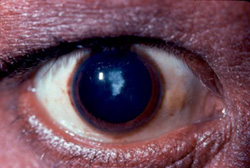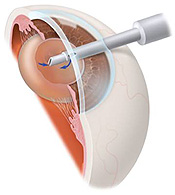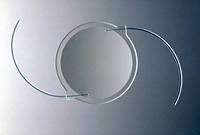Cataracts
Your eye works a lot like a camera. Light rays focus through your lens onto the retina, a layer of light-sensitive cells at the back of the eye. Similar to photographic film, the retina allows the image to be "seen" by the brain.
 Over time, the lens of our eye can become cloudy, preventing light rays from passing clearly through the lens. The loss of transparency may be so mild that vision is barely affected, or it can be so severe that no shapes or movements are seen--only light and dark. When the lens becomes cloudy enough to obstruct vision to any significant degree, it is called a cataract. Eyeglasses or contact lenses can usually correct slight refractive errors caused by early cataracts, but they cannot sharpen your vision if a severe cataract is present.
Over time, the lens of our eye can become cloudy, preventing light rays from passing clearly through the lens. The loss of transparency may be so mild that vision is barely affected, or it can be so severe that no shapes or movements are seen--only light and dark. When the lens becomes cloudy enough to obstruct vision to any significant degree, it is called a cataract. Eyeglasses or contact lenses can usually correct slight refractive errors caused by early cataracts, but they cannot sharpen your vision if a severe cataract is present.
 The most common cause of cataract is aging. Other causes include trauma, medications such as steroids, systemic diseases such as diabetes, and prolonged exposure to ultraviolet light. Occasionally, babies are born with a cataract.
The most common cause of cataract is aging. Other causes include trauma, medications such as steroids, systemic diseases such as diabetes, and prolonged exposure to ultraviolet light. Occasionally, babies are born with a cataract.
Cataracts typically develop slowly and progressively, causing a gradual and painless decrease in vision. Other changes you might experience include blurry vision; glare, particularly at night; frequent changes in your eyeglass prescription; a decrease in color intensity; a yellowing of images; and in rare cases, double vision.
As the eye's natural lens gets harder, farsighted (presbyopic) people, who have difficulty focusing up close, can experience improved near vision and become less dependent on reading glasses. However, nearsighted (myopic) people become more nearsighted, causing a worsening in their distance vision. Some kinds of cataracts affect distance vision more than reading vision. Others affect reading vision more than distance vision.
Cataract Surgical Treatment and the Use of "Premium Lenses"
With a routine, outpatient surgical procedure, an ophthalmologist (Eye M.D.) can remove the cataract, making either a small incision (phacoemulsification) or a larger incision (extracapsular extraction). Usually, a synthetic intraocular lens (IOL) is inserted at the time of cataract extraction to replace the focusing power of the natural lens. IOLs can be monovision (fixed-focus for a preset distance) or multifocal, which allows focused vision at many distances. The time to have cataract surgery is when the cataract is affecting your vision enough to interfere with your normal lifestyle.
The type of IOL to use at the time of surgery is determined by your visual needs and the health of your eye. New lenses of different styles and features when they become available may be offered to you if you are a candidate. Some of these features may be included in the lens that your health plan provides but other features may not. If you feel you wish these features and you are a candidate then there is a fee to the provider of these surgical services (hospital or clinic). This decision can only be made by yourself in discussion with your eye doctor.
The policy for the use of these lenses at St. Mary's General Hospital (SMGH) and the rates may be found in the Forms section of this website
 Cataract surgery is a very successful operation. As with any surgical procedure, complications can occur during or after surgery, and some are severe enough to limit vision. But in most cases, vision, as well as quality of life, improves.
Cataract surgery is a very successful operation. As with any surgical procedure, complications can occur during or after surgery, and some are severe enough to limit vision. But in most cases, vision, as well as quality of life, improves.
